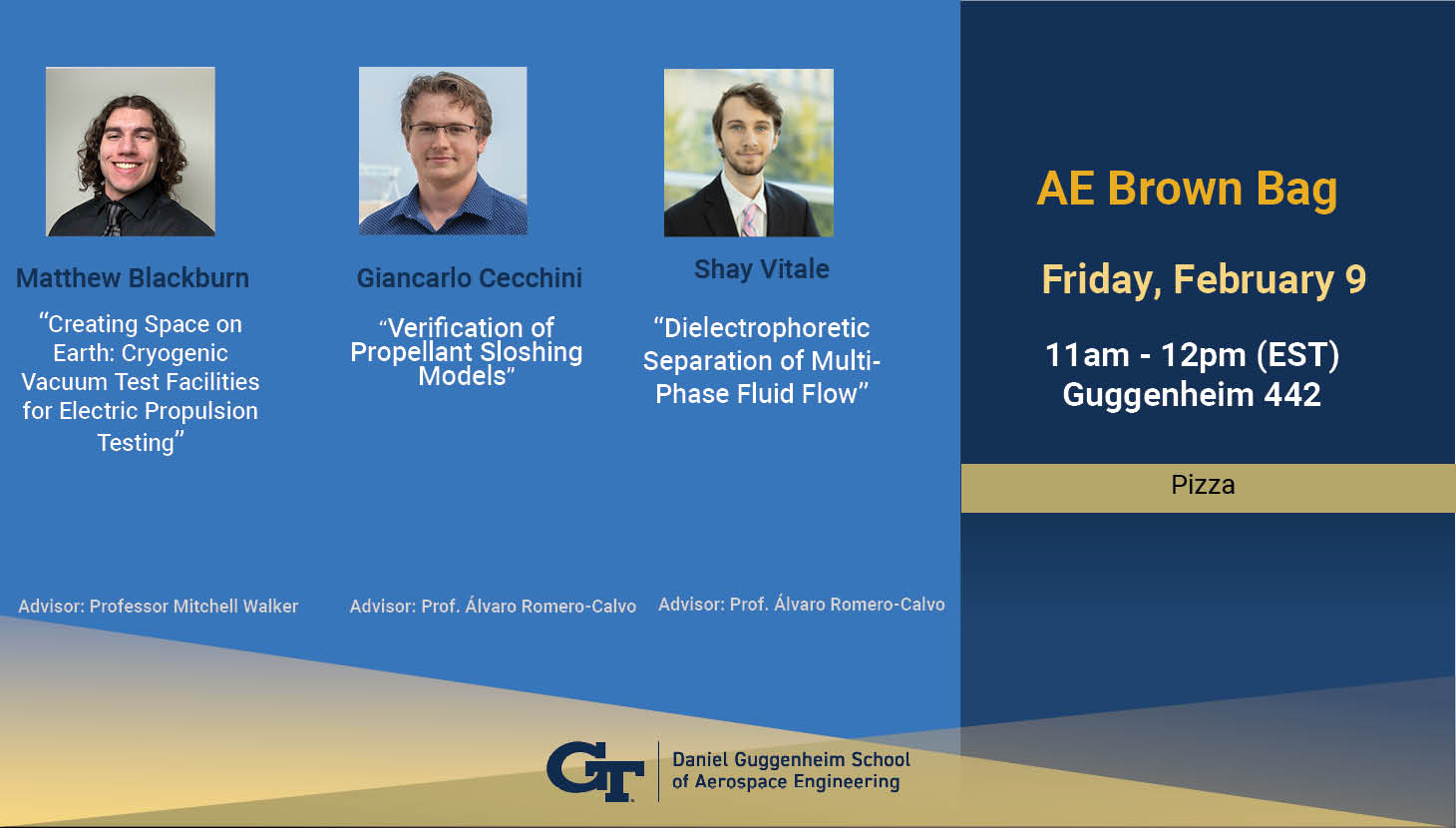
AE Brown Bag Seminar
Friday, February 9
11:00 a.m. - 12:00 p.m.
Guggenheim 442
Pizza Served
Matthew Blackburn
Giancarlo Cecchini
Shay Vitale
Matthew Blackburn
Title:
Creating Space on Earth: Cryogenic Vacuum Test Facilities for Electric Propulsion Testing
Abstract:
This presentation delves into the realm of cryogenic vacuum test facilities designed to maintain high vacuum conditions for electric propulsion diagnostics. As space exploration and satellite missions demand higher performance standards, the necessity for accurate propulsion testing under extreme conditions becomes paramount. The utilization of vacuum testing not only simulates the conditions of outer space but also facilitates a more comprehensive evaluation of electric propulsion systems. This presentation will define the varying levels of vacuum conditions, while also discussing the mechanisms through which these conditions are achieved. Furthermore, this presentation will examine the importance of these conditions with relation to electric propulsion testing and plasma diagnostics. In essence, these facilities emerge as vital assets at the cutting-edge of aerospace testing and research, playing a pivotal role in advancing the understanding and performance of electric propulsion systems.
Advisor:
Professor Mitchell Walker
Giancarlo Cecchini
Title:
Verification of Propellant Sloshing Models
Abstract:
Sloshing" describes the movement of liquids in partially filled containers. Sloshing can significantly impact the dynamics of space vehicles and prevent propellant ingestion. It can induce undesired fluid-structure interactions, affect system dynamics, and potentially lead to mission failure. The impact of sloshing is clearly demonstrated in the 1957 Jupiter Intermediate Range Ballistic Missile, which experienced total mission failure due to liquid sloshing. The fundamentals of sloshing have been studied since the 1960s in both fluid dynamics simulation and the development of mechanical analogies. The objective of the research presented is to validate high-gravity slosh-damping correlations through a real-world test inside an L1 rocket. This validation will be achieved using perpendicular line lasers, pressure transducers, and an axially locked camera for reconstruction of the slosh in MATLAB.
Advisor:
Professor Álvaro Romero-Calvo
Shay Vitale
Title:
Dielectrophoretic Separation of Multi-Phase Fluid Flow
Abstract:
Separation of liquid-gas/solid mixtures is challenged in partial and microgravity conditions due to the reduction in the buoyancy force. Capillary or mechanical phase separation technologies have traditionally been employed to overcome these issues, but they lack the stability and efficiency desired for most space applications. The dielectrophoretic (DEP) wedge offers potential to separate fluids from impurities and byproducts without moving parts. The capillary phase separation effect is complemented with the DEP force generated by electrodes placed along the walls of the wedge. Following the gradient of the electric field, the non-liquid phase migrates towards or away from its vertex depending on its relative electric permittivity with respect to the surrounding medium. The wedge design serves a dual purpose – creating a strong DEP force and exploiting capillarity to stabilize the fluid flow. In low gravity, the capillary wedge has already been proven effective at moving fluids to the hydrophilic vertex of the wedge. However, it also fails to transport smaller bubbles and particles that do not touch the walls of the system. Preliminary results demonstrate the practical advantages of the DEP wedge system, which can contribute to the advancement of sustainable human presence in space by offering new resource processing methods as well as propellant management methods.
Advisor:
Professor Álvaro Romero-Calvo